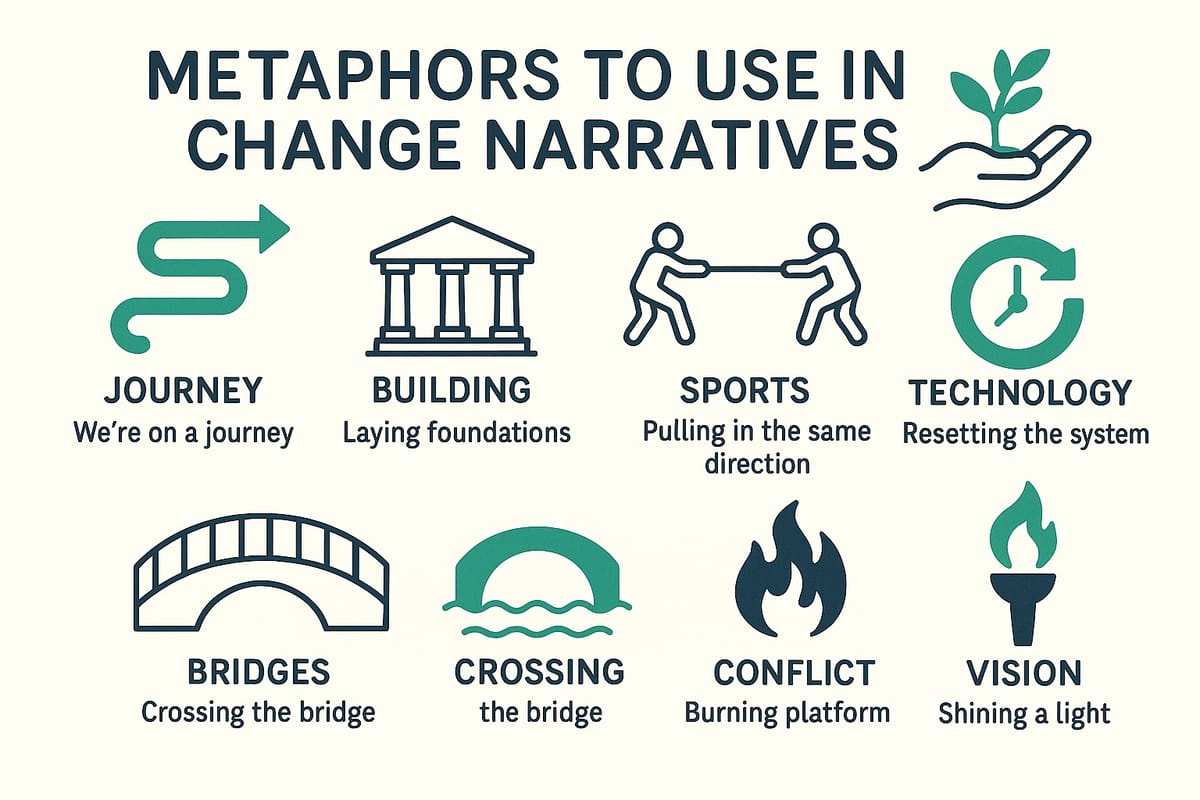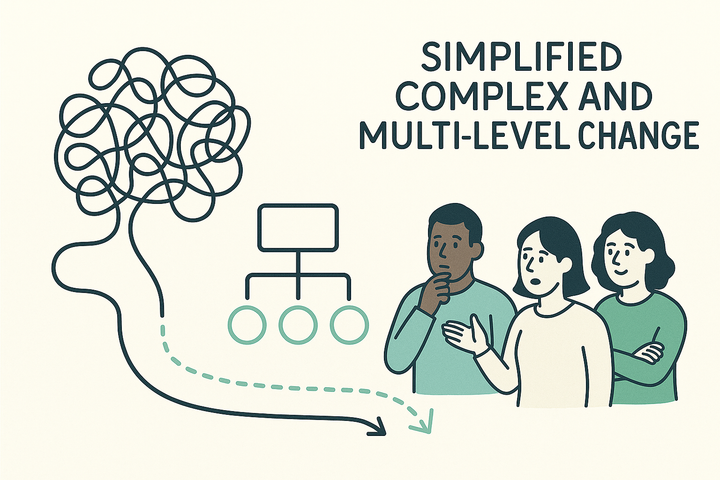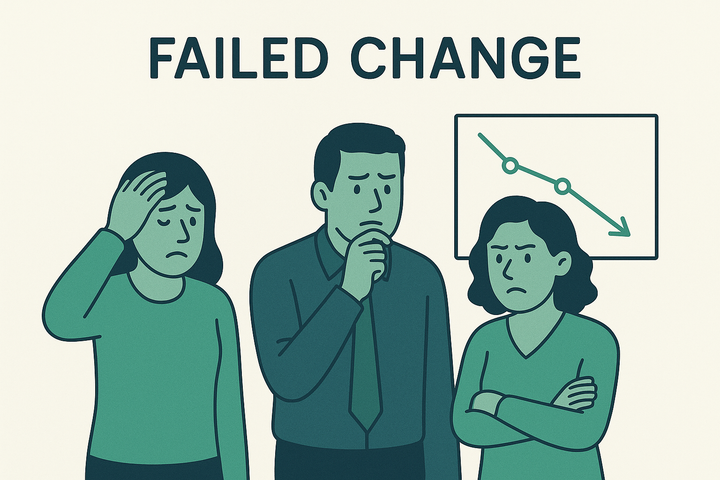Using Metaphors in Change Narratives
The best change messages don’t just inform — they stick. This guide explores how to use metaphors that give meaning to strategy and help people make sense of change.

Why metaphors matter
Strategy doesn’t stick without story. And story doesn’t work without symbols.
That’s where metaphors come in.
Metaphors make the abstract tangible. They let people picture the thing they’re being asked to understand or do. And in the context of change — where uncertainty is high and cognitive load is real — metaphors do something that bullet points never can: they help people feel the message, not just receive it.
When used well, a metaphor becomes more than language. It becomes shared understanding. It turns a vague “strategic direction” into something your people can carry, repeat and act on.
What a good metaphor does
A well-chosen metaphor in change communication:
- Makes the complex simple
- Connects emotionally as well as logically
- Creates consistency across messages, teams and leaders
- Anchors meaning during ambiguity
- Builds internal language that becomes part of culture
It’s not a decoration. It’s a strategic tool. One that turns change from something imposed to something people can actually understand and ground in their own reality.
8 metaphor categories for change narratives
These aren’t random images — they’re tried and tested metaphor types that shape how people internalise and act on change.
1. Journey and travel
These are the classics — and with good reason. Change often unfolds over time, with phases, pivots and destinations.
Examples:
“We’re on a journey.”
“We’re mapping a new route.”
“We’re changing course.”
“There’s a mountain to climb.”
Best used when:
You’re trying to show phased progression, directional movement, or a transformation that will unfold over time.
Watch for:
Journey fatigue. It’s overused and vague unless grounded in something real.
2. Building and architecture
These metaphors work well for structured, strategic change. They let people visualise frameworks, phases, and stability.
Examples:
“We’re laying the foundations.”
“This is the blueprint for our future.”
“We’re constructing a stronger system.”
“We’re rebuilding from the ground up.”
Best used when:
You’re designing or redesigning organisational structures, capabilities or systems.
Watch for:
Overcomplexity. Make sure your “blueprint” doesn’t turn into a metaphorical maze.
3. Nature, growth and evolution
These metaphors are human, organic and often more inclusive. They imply change is natural, necessary and part of a wider cycle.
Examples:
“We’re planting seeds.”
“We’re entering a new season.”
“We’re evolving how we work.”
“We need to prune before we grow.”
Best used when:
The change is cultural, long-term, or emotionally sensitive. These metaphors soften the edge while still being honest.
Watch for:
Too much softness. Nature metaphors need grounding in action.
4. Bridges and transitions
These are powerful when you’re in the messy middle. When the old is gone but the new hasn’t landed yet.
Examples:
“We’re crossing the bridge.”
“We’re in the transition zone.”
“We’re bridging the old and the new.”
Best used when:
The organisation is between states — post-announcement but pre-embedding.
Watch for:
Overuse without guidance. If you say you’re on a bridge, people need to know what’s on the other side.
5. Sports and teamwork
These bring energy and urgency. They also reinforce shared effort and personal accountability.
Examples:
“We’re playing the long game.”
“We need to pull in the same direction.”
“This is a team sport.”
Best used when:
You want to energise or unite teams around delivery, especially when collaboration is essential.
Watch for:
Sports metaphors can alienate if overused or culturally tone-deaf.
You might also like:
- Creating a Change Narrative
- Using Metaphors in Change Narratives
- The Art of the Backstitch – Why You Need to Return and Return Again to Your Narrative
- Change and Transformation Visions – Painting the Future State
- The Four Types of Organisational Change and How to Communicate Them
6. Technology and systems
Ideal for transformation programmes, process change or digital upgrades.
Examples:
“We’re rewiring how we work.”
“We’re upgrading our capabilities.”
“We’re resetting the system.”
Best used when:
Your change is operational, technical or deeply process-based.
Watch for:
Jargon creep. These metaphors work best when humanised.
7. Conflict and urgency
These metaphors are bold, decisive and high-impact. But they need to be used with precision.
Examples:
“There’s a burning platform.”
“We’re at a crossroads.”
“This is our moment of truth.”
Best used when:
The risk of inaction is real, and you need to create urgency. These metaphors cut through apathy and denial.
Watch for:
Fear-based messaging. If you burn the platform without building a bridge, people freeze.
8. Vision and light
Inspiring, future-focused, often used by senior leaders. These metaphors help people orient themselves in uncertainty.
Examples:
“We’re lighting the path ahead.”
“We need a clear line of sight.”
“Our vision is coming into focus.”
Best used when:
You’re moving from problem to solution, and trying to energise around potential.
Watch for:
Vagueness. “Light” only works if people know what it’s illuminating.
What to avoid
Mixed metaphors
“We’re on a journey, laying the foundation, while rewiring how we think” is not a compelling message. It’s a migraine.
Metaphors that don’t match reality
If the change feels chaotic, don’t describe it as a neat upgrade. People know when they’re being sold something untrue.
Overused language
“Journey” and “burning platform” are everywhere. If you use them, root them in the specific context of your organisation.
Metaphors without behaviour
If your chosen image doesn’t influence what people do, it’s not doing its job.
How to choose the right metaphor
- Start with your audience. What language will resonate with them? What are they tired of hearing?
- Match it to the emotional truth of the change. What does this moment feel like to the people going through it?
- Be consistent. Pick one primary metaphor and stick with it across leaders, messages and channels.
- Build it in. Don’t just say it once. Weave it into the story. Use it in visuals. Make it part of the environment.
Final thought
Metaphors aren’t fluff. They’re frameworks. They give people a mental map — something to hold onto when the landscape is shifting.
If you want your message to land, pick an image that’s honest, human and true. Then use it to help people move — not just listen.
Need help shaping your change narrative?
Our founder, Gail Hackston, is a seasoned senior interim change communicator who’s helped organisations align leaders, engage teams and land real transformation. Contact her at Rewired Work or via her LinkedIn profile to explore how she can support your change communications.



